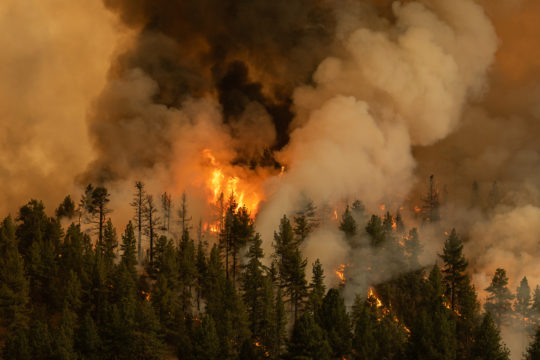A heat wave, or heatwave, is a period of excessively hot weather, which may be accompanied by high humidity, especially in oceanic climate countries. While definitions vary, a heat wave is usually measured relative to the usual climate in the area and relative to normal temperatures for the season.
They often result in increased mortality rates due to heat-related illnesses, such as dehydration, heat exhaustion, and heat stroke. Elderly people, young children, and sick people are especially vulnerable to the effects of heat waves.
High temperatures can also cause wildfires, power outages, and transportation disruptions. In order to protect yourself and others during a heat wave, it is important to stay hydrated, stay in air-conditioned areas as much as possible, and avoid strenuous activity. If you must be outside, take frequent breaks in a cool, shady area.
Causes of Heat Waves
There are a few different ways that heat waves can occur. One common cause is a strong high-pressure system that traps warm air near the ground. Another cause can be a warm ocean current that raises the temperature of the air above it.
Climate Change
Climate change is also causing an increase in the frequency and intensity of heat waves around the world. As the Earth’s atmosphere warms, hot weather events are becoming more common. High temperatures are expected to become even more severe in the coming years as climate change continues to progress.
Impacts of Heat Waves
Heat waves can have serious impacts on public health, infrastructure, and the economy. They are one of the leading causes of weather-related death in the United States. They can also cause power outages and transportation disruptions.

Heat Waves in the United Kingdom
In July 2022, the United Kingdom (UK) experienced its first-ever national heat wave. The event was caused by a warm air mass that moved north from continental Europe. temperatures in the UK reached 40°C (104.5°F) in some areas, which broke the previous record of 36.7°C.
It led to an increase in hospital admissions for heat-related illnesses, as well as a spike in demand for air conditioning units. The event also caused disruptions to transportation, with speed restrictions being imposed on trains due to the risk of tracks buckling in the heat.
In the UK, high temperatures are expected to become more frequent and more intense as climate change progresses. The country is working to adapt to the changing climate, but high temperatures will still pose a serious threat to public health and infrastructure.
European Union
Heat waves struck the European Union (EU) throughout the summer of 2022. Record-breaking temperatures were recorded in early July led to temperatures of over 40°C (104.5°F) in some areas. This was followed by another one in August, which caused widespread power outages and transportation disruptions. Countries affected included France, Germany, Italy, Spain, and many others. They led to an increase in hospital admissions for heat-related illnesses, as well as a number of deaths.
Australia
Australia is no stranger to heat waves, with the country experiencing several each year. The most recent notable event was the 2019–20 summer heat wave, which affected most of the country. In 2022, in the state of Victoria, temperatures reached 46°C (114.8°F) in some areas. The event caused widespread power outages and prompted the state government to declare a state of disaster.
Heat Waves in the United States
In the United States, heat waves are becoming more common and more intense due to climate change. A notable event was in which affected much of the Midwest and East Coast. Temperatures in some areas reached 40°C (104°F), and led to more than 130 deaths.
California
California is particularly vulnerable to heat waves due to its large population and diverse climate. The state experiences several such events each year, with the most recent being in 2022.
New York
New York City is also vulnerable to heat waves due to its large population and dense urban environment. The city experienced a major heat wave in July 2021, with temperatures reaching 41°C (105.8°F). The event caused widespread power outages and transportation disruptions. In 2022, a heat wave struck the city again, leading to another round of power outages and transportation disruptions.
Heat Waves in Canada
Canada is also experiencing more frequent and intense heat waves due to climate change. A notable event was in 2016, which affected the western part of the country. Temperatures in some areas reached 40°C (104°F), and the temperatures led to several deaths. In 2022, abnormally high temperatures struck the country, this time affecting the eastern part of the nation.
With climate change causing an increase in the frequency and intensity of high temperatures around the world, it is important to be prepared for these events. High temperatures can have serious impacts on public health, infrastructure, and the economy. They can also cause power outages and transportation disruptions.
New Zealand
In New Zealand, heat waves are becoming more common and more intense due to climate change. In 2022, another heat wave struck New Zealand, this time affecting the North Island. Temperatures in some areas reached 40°C (104°F), and led to a number of deaths.
Carbon Offsets
Carbon offsets can help to reduce the impact of heat waves. Carbon offsets are payments made to offset carbon emissions. The payments are usually made to support projects that reduce carbon emissions, such as planting trees or investing in renewable energy. Such projects are a crucial tool in the fight against climate change and can help to mitigate the impact of high temperatures
Infrastructure Improvements
Improving infrastructure can also help to reduce the impact. For example, installing air conditioning units in homes and businesses can help to keep people cool. Upgrading the power grid can help to prevent widespread blackouts. And improving the transportation system can help to keep people moving during a heat wave.
Such improvements, however, may also have a negative impact on the environment. For example, air conditioning units use a lot of energy and emit greenhouse gases that contribute to climate change. As such, it is important to offset any emissions from infrastructure improvements with carbon offsets.

